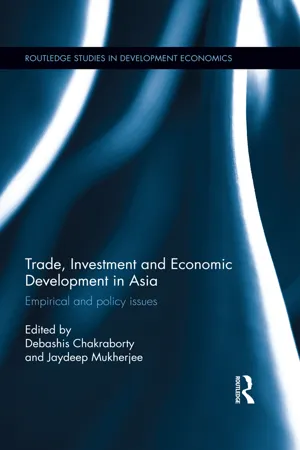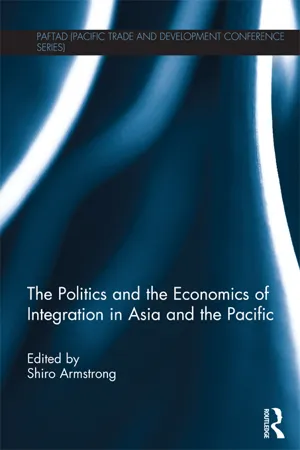Economics
International Trade In Asia
International trade in Asia refers to the exchange of goods and services between countries in the Asian region. It plays a significant role in the global economy, with countries like China, Japan, and South Korea being major players. Asia's trade is characterized by exports of manufactured goods, electronics, and machinery, as well as imports of raw materials and energy resources.
Written by Perlego with AI-assistance
Related key terms
Related key terms
1 of 4
Related key terms
1 of 3
5 Key excerpts on "International Trade In Asia"
- Debashis Chakraborty, Jaydeep Mukherjee(Authors)
- 2016(Publication Date)
- Routledge(Publisher)
Editors’ introduction An Asian perspective of global trade and investment dynamicsDebashis Chakraborty and Jaydeep MukherjeeEvolving trade-investment nexus: through the looking glass of literature
Over the last two decades, countries have embarked upon several alternate tracks (viz., unilateral, bilateral, regional and multilateral) to liberalize and deepen their linkage with the world economy. This growing strength of globalizing forces have resulted in a phenomenal rise in world trade and investment flows over the past three decades, which has been hailed by the multilateral bodies. The World Trade Report (2013) has noted that in gross terms, the dollar value of world merchandise trade has increased by more than 7 per cent per year on average between 1980 and 2011, reaching a peak of US$18 trillion at the end of that period. The trade in commercial services grew even faster, at roughly 8 per cent per year on average, and stood at around US$4 trillion in 2011. In all, since 1980, world trade has grown on average nearly twice as fast as world production (WTO 2013).The evolving volume and pattern of trade and investment flows has called for fresh inquiries through advancements in theoretical and empirical frameworks for explaining them in newer light from time to time. The rise in trade across countries at similar development planes from the sixties onwards highlighted the limitations of the traditional factor endowment model in explaining these trade flows and paved the road for intra-industry trade (IIT) models, which explains simultaneous exports and imports within product categories (Grubel and Lloyd 1975). Empirical investigations have revealed that a significant proportion of trade flows across countries are of the IIT type, explained by trade in parts and components, and the trend has only deepened in the recent period. The IIT analytical framework has been further extended, with segregation of overall IIT in vertical and horizontal types (Greenaway, Hine and Milner 1994), and the growing literature on this front imparts deeper understanding of trade patterns.- Anthony Webster, Ulbe Bosma, Anthony Webster, Ulbe Bosma, Kenneth A. Loparo, Anthony Webster, Ulbe Bosma, Jaime de Melo(Authors)
- 2015(Publication Date)
- Palgrave Macmillan(Publisher)
16Similarly, what I have in mind in this chapter as typical instances of intra-regional transactions are as follows: in the case of India, transactions among 12 regional blocs as defined by statistics on rail-borne trade that were recorded towards the end of the nineteenth century.17 In the case of Southeast Asia, transactions between the administrative divisions that existed at the time of colonisation during the latter half of the nineteenth century and those within the Dutch East Indies, for example between Java and Madura, on the one hand, and the Outer Islands, on the other. Last, in the case of China, transactions among the market spheres focused around the treaty ports that existed at the end of the nineteenth century.18 Since these trading spheres had not yet entirely formed by 1840, it is of course impossible to estimate directly the value of intra-regional transactions. All that is possible is to intuitively make inferences from small amounts of information, by keeping the concept of trading spheres in mind.I would like to elaborate on this point a little further. In the year 1840, when the total value of world trade, according to Appendix 2.1 , is deemed to have stood at 325 million pounds or thereabouts, the value of domestic trade within China was 100 million pounds according to one estimate.19 In my 2009 paper, I took 10 per cent of the latter figure as an estimate of the value of domestic transactions conducted over relatively long distances. One factor that underpinned this decision was a report written by a British man shortly after the opening of the treaty ports in the 1840s. The report points out, for example, that in Fuzhou in 1846, commodities shipped into and out of the city by junks amounted to 15.21 million dollars, and commodities worth 1.14 million dollars were traded by land. Converted at the rate of 0.21 pounds to the dollar, the total adds up to approximately 3.4 million pounds. Moreover, there must have been a lot of smuggling. The items traded consisted not only of goods for prospective export, such as tea and silk, but also a wide variety of daily necessities, such as beans, fish, salt, sugar, cotton cloth, wood and paper. To what extent this description faithfully portrays the day-to-day situation remains unknown, but judging from the contents of reports made before and after these statistics – including in particular a detailed list of merchants who were involved in these transactions and descriptions about the state of the market – there is no doubt that traditional transactions involved not only local products, but also imports from Southeast Asia, and as such really deserve to be termed intra-regional transactions.20- eBook - ePub
- Linda Yueh(Author)
- 2009(Publication Date)
- Routledge(Publisher)
In this paper, we sketched out some of the overall characteristics of more integrated regional growth, including general indications about policy initiatives that will be needed to facilitate this. Building the institutional basis for regional integration is the work of governments, however, not economists. An Asian OECD would provide a convenient venue for this work, but the initiative must be animated by a clear understanding of the potential benefits. Our results indicate that regional integration has more to offer Asia than the WTO itself, although the two should not be seen as substitutes.Whichever path Asia chooses, rich opportunities are there for stimulating growth through trade diversification. Our results indicate that the volume of trade with traditional partners can continue to grow, but that superior growth in Asia can sustain and indeed be sustained by policies that promote faster trade growth within the region. As the region transits from historical patterns of North–South specialization to a family of more modern, diversified, and integrated consumer societies, the vestiges of head-to-head export competition will give way to a more collaborative basis for growth. This approach represents the best strategy to fulfill the immense economic promise of Asia for all of its people, over half of humanity.Annex – Overview of the SAGE model and data
Model specification
The complexities of today’s global economy make it very unlikely that policy makers relying on intuition or rules-of-thumb will achieve anything approaching optimality in either the domestic or international arenas. Market interactions are so pervasive in determining economic outcomes that more sophisticated empirical research tools are needed to improve visibility for both public and private sector decision makers. The preferred tool for detailed empirical analysis of economic policy is now the Calibrated General Equilibrium (CGE) model. It is well suited to trade analysis because it can detail structural adjustments within national economies and elucidate their interactions in international markets. The model is more extensively discussed in the annex and the underlying methodology is fully documented elsewhere, but a few general comments will facilitate discussion and interpretation of the scenario results that follow. - Shiro Armstrong(Author)
- 2011(Publication Date)
- Routledge(Publisher)
A key aspect of the pattern of the integration observed in East Asia today is its highly unbalanced nature, in terms of its heavy concentration on electrical machinery and on intermediate goods trade as a result of production fragmentation. To a considerable extent this reflects the large income differences found in East Asia, which provide the basis for fragmentation trade and are partly responsible for the dependence on export demand from outside the region. However, it certainly also reflects the policy environment, which has concentrated on attracting export-oriented FDI by facilitating trade in intermediate products through tariff rates on intermediate goods lower than on final goods (as seen in the case of the automotive industry), duty drawback schemes, export-processing zones and bonded warehouses. Ignoring such intermediate goods trade to keep Factory Asia running, East Asia's dependence on markets outside the region, if anything, has increased over the past 15 or so years.The 2008–09 global economic crisis vividly illustrated the vulnerability of reliance on Western export markets, suggesting that, in order to redress global imbalances and to put growth in East Asia on a more self-sustained footing, it is important that the demand-side aspect of regional integration catches up with the level of supply-side integration already achieved in some industries. As the example of the electrical machinery industry shows, the countries in the region are already becoming increasingly important markets for each other when trade not only in intermediate but also in final goods is relatively unimpeded. This suggests that, in addition to policies geared toward domestic demand-led economic growth, countries in the region should focus on creating a policy environment that promotes trade in final goods and hence forms of international division of labour other than the fragmentation of production. Whether a ‘noodle bowl’ of bilateral FTAs is the best way to achieve this is questionable, but currently there appear to be few alternatives on the horizon.NOTES
1 Institute of Economic Research, Hitotsubashi University, 2-1 Naka-Kunitachi, Tokyo 186-8603, Japan. Email: [email protected] .2 Faculty of Economics, Senshu University, 2-1-1, Higashi-mita, Tama-ku, Kawasaki, Kanagawa 214-8580, Japan. Email: [email protected]- eBook - ePub
- Sook Rei Tan, Haejin Jang, Jacob Wood(Authors)
- 2024(Publication Date)
- Routledge(Publisher)
1 Trade and Development in Asia A Post COVID-19 Economic AssessmentJacob Wood, Haejin Jang, and Sook Rei TanDOI: 10.4324/9781003349204-11.1 Introduction
International trade has always been an important driver of economic growth and poverty alleviation in Asia (Heshmati et al., 2019 ; Kim & Wood, 2020 ; Wood & Wu, 2020 ; Du et al., 2021 ; Wood et al., 2021 ; Wu et al., 2021a, 2021b, 2022 ). International trade has also allowed Asian economies to exploit economies of scale by specializing in productive activities in which they have a comparative advantage. Furthermore, trade has also helped boost investment and productivity by allowing for the faster spread of technology, including through links formed when participating in global value chains (GVCs) – trade in intermediate inputs. In addition to this has been a climate in which tariff levels have continued to fall and remain a relatively low barrier overall in the region. However, despite these changes, new measures of nontariff barriers remains relatively high in many Asian emerging markets and developing economies (Wood, 2017 ; Wood et al., 2017a , 2017b, 2020 ). Unlike tariffs, these non-tariff measures include policies that introduce new potential barriers such as new health and safety standards or licensing requirements that has restricted not only trade but also payments, or the exchange of foreign currencies.In addition to these issues has been the profound impact that the COVID-19 pandemic has had on trade and economic development in the region since early 2020 (Atkinson et al., 2022 ; Wood et al., 2022 ; Wu & Wood, 2022 ). Despite the impact, GDP forecasted to fall across the Asia-Pacific region in 2021/22 (see Table 1.1 ), it remains among the fastest growing areas in the world (IMF, 2021
Index pages curate the most relevant extracts from our library of academic textbooks. They’ve been created using an in-house natural language model (NLM), each adding context and meaning to key research topics.
Explore more topic indexes
Explore more topic indexes
1 of 6
Explore more topic indexes
1 of 4




